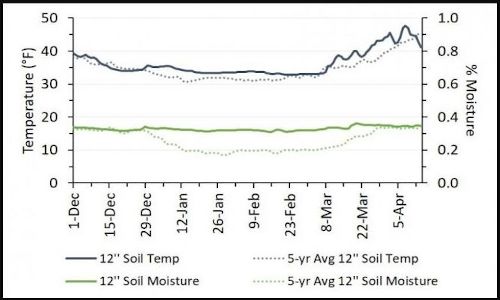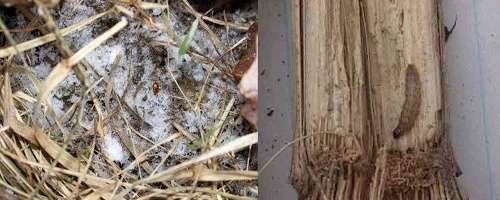Insects do not generate their own body heat
Insects assume an internal body temperature similar to their environment, leaving them vulnerable to harsh winter weather and fluctuating temperature regimes. Most insects do not develop or function at temperatures below 50°F, but they do not typically freeze until temperatures are well below -4°F during overwintering. An ICM encyclopedia article describes several ways insects can survive the winter in Iowa.
Overwintering insects select sites that are protected from these extreme air temperatures. Insects that overwinter in the soil are more buffered from extreme temperatures (Figure 2), especially if snow cover is present. Examples of insects that overwinter in the soil in Iowa include corn rootworm, Japanese beetle, and wireworms, and examples of insects that overwinter above ground in Iowa include bean leaf beetle (plant litter), soybean aphid (buckthorn leaf buds), and European corn borer (corn stalks; Figure 3).

Figure 2. Daily average 12-inch soil temperature and moisture in Ames (solid lines) from December 1, 2019 to April 14, 2020 compared to the averages for the previous 5 years (dotted lines). Data courtesy of the Iowa Environmental Mesonet.

Figure 3. Bean leaf beetle overwintering in crop residue. Photo by John Obermeyer. European corn borer overwintering in corn stalks. Photo by Steve Ebelhar.
Mild winters
Warmer winters are likely to increase survival because insects will not be exposed to lethal temperatures. However, if insects resume activity during unseasonably warm spring weather when temperatures are fluctuating, they may deplete their energy reserves before their host is available. Usually, insects have ways to protect themselves from this, which typically include emerging in response to some other stimulus instead of temperature. Insects in the soil are unlikely to experience lethal temperatures in any year, but mild winters could result in repeated freeze-thaw cycles that can reduce their survival.
Cold snaps
If temperatures are not low enough to cause mortality, exposure to cold temperatures has sublethal effects such as reduced growth, development and reproductive potential. Repeated cold exposures can increase survival relative to sustained cold temperatures for most insects, but this is highly dependent on duration and temperature.
Once development resumes in the spring, exposure to temperatures below 50°F can cause insects to enter a chill coma, where development and movement cease until favorable conditions resume. They can experience injury during this time, the extent of which depends on the duration and the temperature. If temperatures are greater than 32°F for a short period of time, insects will likely survive. Survival could be reduced with below-freezing temperatures or increased duration of exposure. Most insects would likely survive brief exposures to temperatures in the 20s, but fewer would survive temperatures in the teens. Much of this depends on whether they are still in a cold-hardy state.
Typically, diapause is terminated sometime mid-winter and insects remain in a dormant state until favorable conditions arise. It is important to remember that insects do not emerge from overwintering all at once; therefore, some individuals of a species were likely still dormant during the recent cold snap.
What does this mean?
Even if conditions are likely to cause mortality within a particular species, some individuals will survive and infest crops. Even in years when winter mortality is high, pest species can increase their populations rapidly in the summer if conditions are favorable. We expect most insects were able to survive the 2019-2020 winter weather and likely survived the recent cold snap as well.
Source : iastate.edu